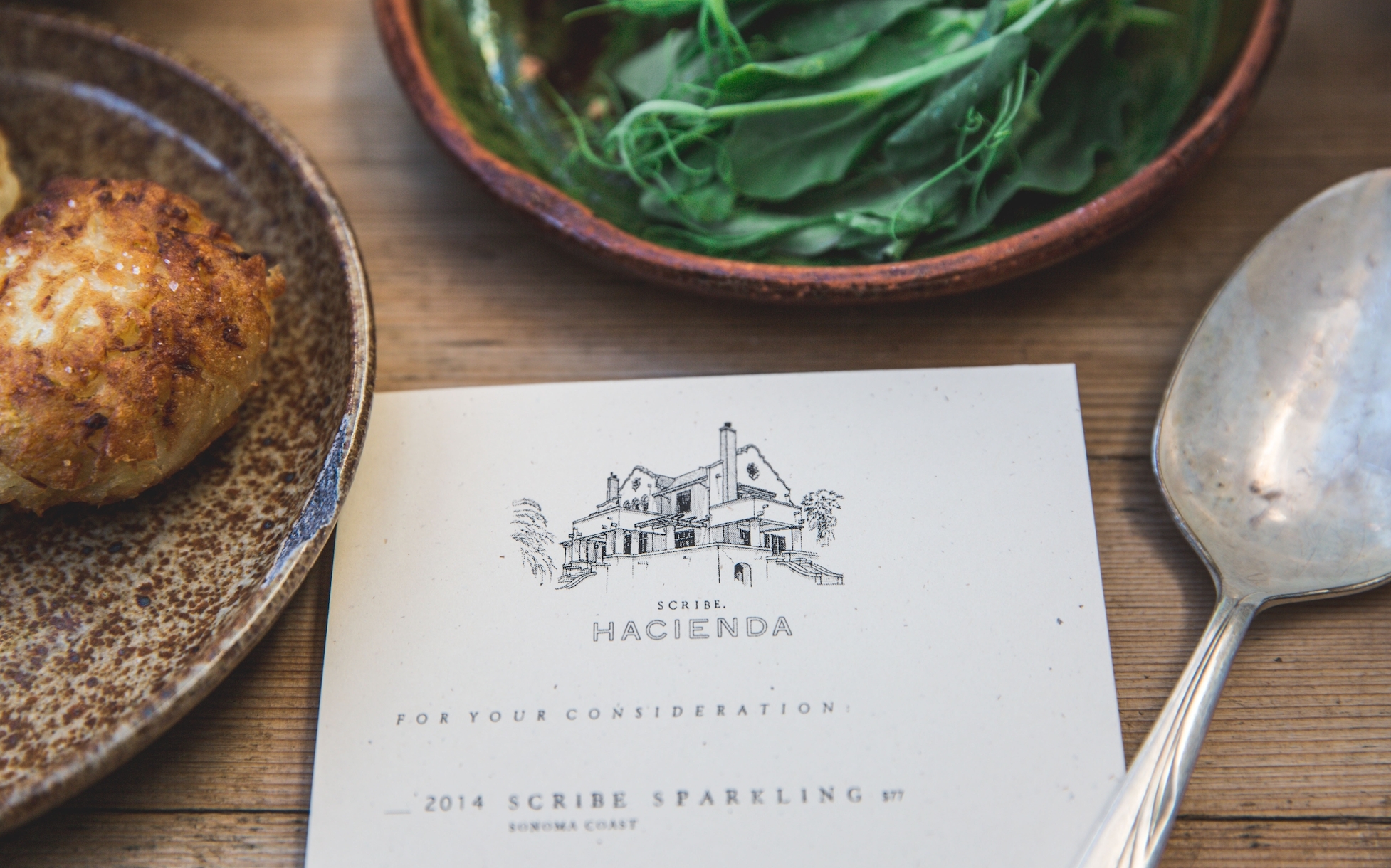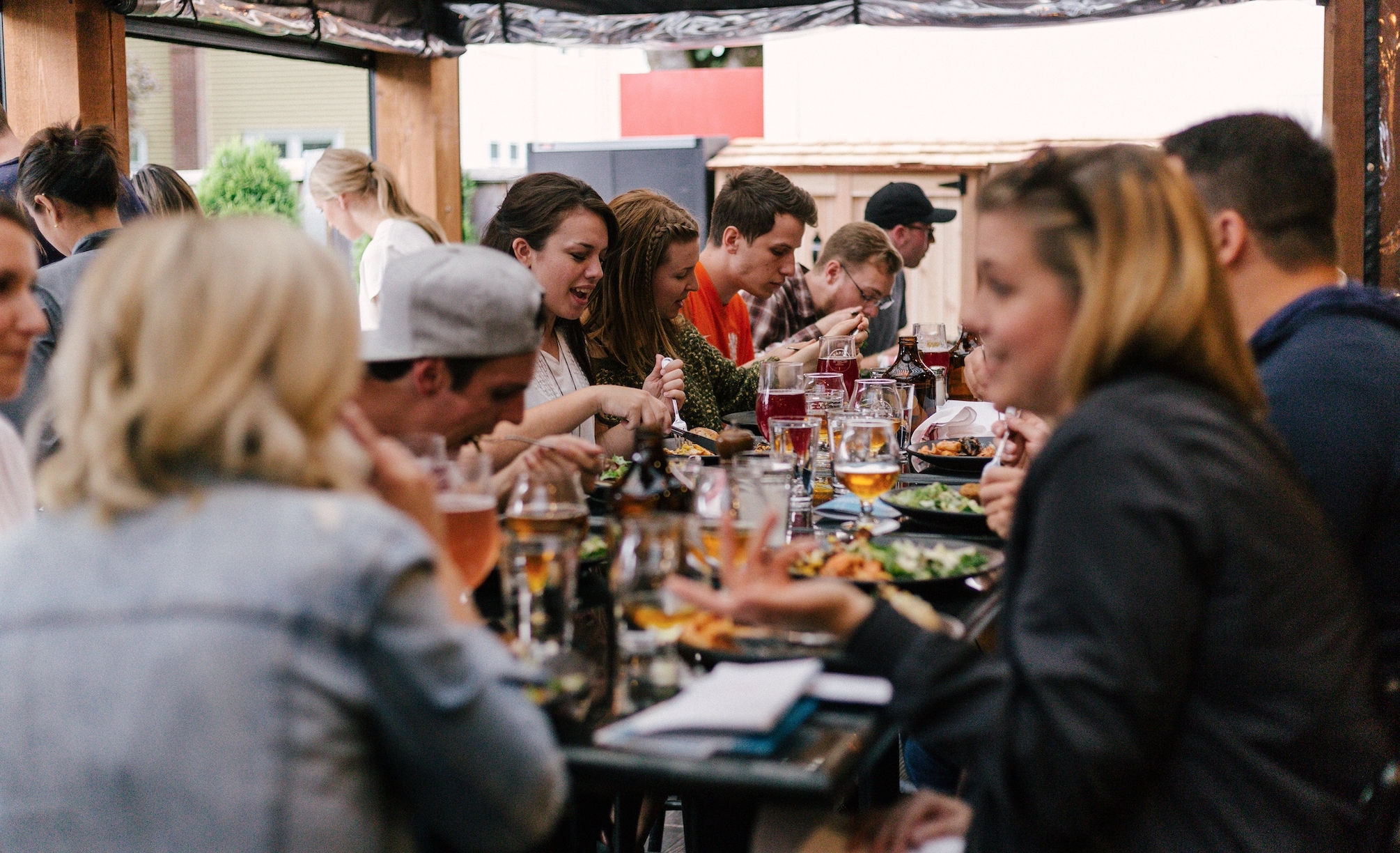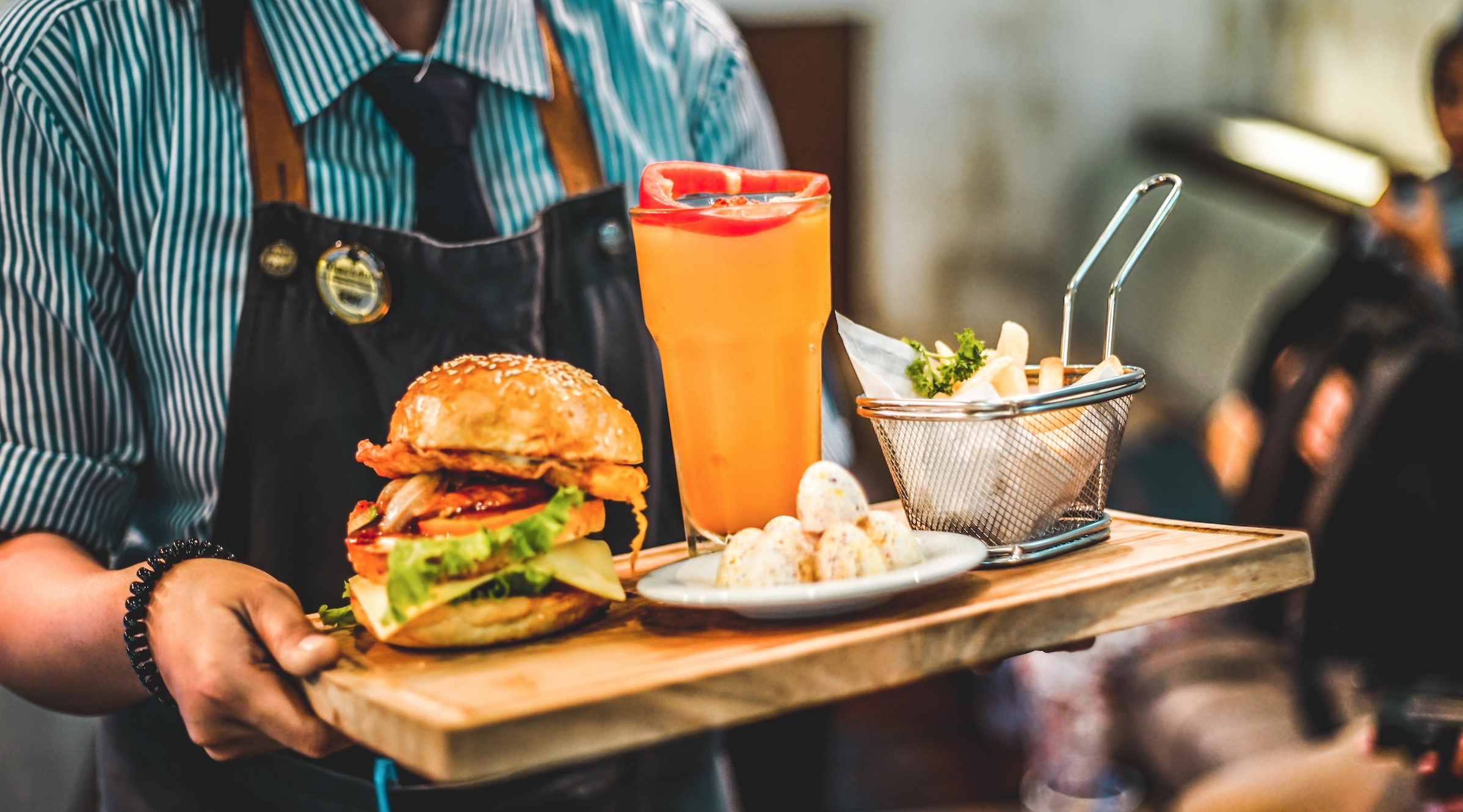“There’s nothing worse than hearing after a visit that someone suffered in silence through a drink or meal they didn’t like.”
These are the wise words of Iain Griffiths and they’re emblematic of how great bartenders, chefs, hosts, and servers feel about every meal or drink they serve. Griffiths, like me, came up in the high-end world of service. While I refined my skills in Neapolitan pizzerias in Washington, DC, organic wine bars in Prague, and cocktail bars in Berlin, Griffiths was flipping the whole London cocktail scene on its head.
Griffiths and Mr. Lyan won World’s 50 Best Bars more than once for their Dandelyan installation in London (which low-key had one of the best bar-food menus I’ve ever tasted). Griffiths then went on to start the Trash Collective with his partner Kelsey Ramage — helping bars and bartenders shift how they approach sustainability and waste. After touring the concept, Griffiths and Ramage opened Supernova Ballroom in Toronto, combining the exceptional world of Dandelyan with the ethos of the Trash Collective. Oh, and amidst all of that, Griffiths somehow had time to do a Dandelyan pop-up in Manhattan called Lyaness.
Which is all to say, this man knows service far better than most. So when the UPROXX “Friday Slack” conversation turned to when to send food or drinks back, I reached out to Griffiths to offer insight into the other side of the equation. I wanted to get everything on the table because the idea of sending something back is clearly pretty fraught for a lot of people. More so than I ever realized. Hopefully, with Griffiths on board, we can dive in and figure it all out together.
PART I: SOMETIMES THE MENU ISN’T ENOUGH

“Drinks, clothes, music, it’s all very personal,” Griffiths says, “and the notion that you can read two lines on a piece of paper and know immediately whether that drink or meal is for you is ridiculous.”
Relying on a menu isn’t always the way to go. Perhaps it’s better to think of a menu as more a map that represents terrain but is not actual terrain. Yes, that piece of paper or image on your phone will give you information for navigating a place. But there’ll always be nooks-and-crannies that affect the experience far beyond what any abstract representation can predict.
Translation: You need to talk to servers and bartenders to get a real sense of what those words on the menu really mean. Assuming is not enough and puts the onus on you. (This doesn’t mean you can monopolize their time, have clear questions and be direct.)
Here’s an example from The Crack Shack:
Firebird
Spicy fried thigh, cool ranch, crispy onions, pickles, potato roll
From the top, “spicy fried thigh” leaves a lot of green for interpretation of how “spicy” that chicken is going to be. Will it be Nashville hot chicken hot? Likely not, but the menu item is called “Firebird” so you, as the guest, must expect a modicum of heat. That feels fair, right?
What, then, if this sandwich is too hot for you? Well… kind of tough shit. “Fire” and “spicy” are in the description clearly enough that you know what you’re in for, at least on a base level. The best advice we can give is to ask the server when you order “how hot is the firebird” and gauge from there. If you order this, find it too spicy, and your server offers to take it back, know that this is being done out of magnanimity by your server. Tip accordingly.
Now, let’s say you order this exact menu item and ask them to hold the pickles because you’re allergic to cucumber. First, you don’t have to tell the server you’re allergic to cucumber as an excuse to hold pickles. Simply asking to hold the pickle should be more than enough information for the server to relay to the chef. If that order then comes out with pickles, you are 100-percent in your rights to send it back. And not just for a pickle scrape, for a whole new sandwich.
If you’re sending back something where you asked to hold an ingredient that wasn’t held, politely inform the runner (or flag down a server) and ask that they remake the order without pickles because it’s not what you asked for. (If you’re not allergic but have a distaste for pickles, asking for a whole new sandwich is within your rights but seems wasteful.)
The key is to be patient and polite. As Griffiths notes, “No one gets it right all the time, neither the guest or the bartender.”
PART II: KNOW HOW TO RETURN SOMETHING WITHOUT MAKING A SCENE

“I think this is all about the approach,” Griffiths says when I ask him about returns. “If your drinks were served tableside, then you should most definitely wait until your server approaches the table.”
So, let’s say your order is incorrect or simply something you don’t like — a matter that comes up a lot in cocktails. Griffiths and I whole-heartedly agree that “be discreet” is the most important aspect of returning something or asking for a replacement. Shouting over a table of friends at a server that something is wrong embarrasses the server and will likely set your drinking companions on edge. Find your moment and relay your information calmly and with a sense of empathy. Remember, everyone makes mistakes, you included. Or, as Griffiths put it, “treat it like you were trying to pay the bill with no one watching.”
Also important: Know what’s wrong. If it is the wrong drink, that’s an easy fix. Simply discreetly inform the waitstaff and move on. But let’s say, you ordered the drink or dish, the menu didn’t offer enough information, and now you simply don’t like what is in front of you. Servers (and chefs) are here to give you the best experience with the little time you’ll spend with them, so it’s not crazy to ask for something else. But — and this is a big but — know exactly what you don’t like about the drink/dish.
“Telling your server that you don’t like the order leaves them with nowhere to go,” Griffiths says. “Is it too sweet/sour/bitter? Made with the wrong spirit? Containing something you’re allergic to but forgot to mention? Details have never been more important than these moments.”
Examples[to the server/ bartender]:
“Wow, I had no idea there would this much ginger. I don’t think I can manage this.”
“Oh, there’s so much bone marrow in this drink that it’s coating my palate and I’m afraid I won’t be able to taste my food later. I’m so sorry, is there any chance I can try something else?”
Be as specific as you can be so the server knows the direction to head in order to fix your experience. Again, tip accordingly based on whether or not you asked questions before ordering. If you asked about the ginger level and you were told it was no big deal, then you get a pure ginger shot with some vodka floated on top, it makes more sense to send the drink back.
The best example of this manifests in the food world when it comes to cooking meat. I’m someone who legitimately orders their steaks and burgers (in a steakhouse, not a diner) by temperature. One, because while the server doesn’t always know those scales, the chef and cooks have to. Two, “medium” or “rare” means different things to different people and in different cultures. I don’t expect everyone to do this. That being said, if you order a steak or burger a certain way, it should come out the way you ordered it. If it’s not, remember, discreetly flag down your server and tell them exactly what’s wrong.
Examples [to the server]:
“How do you feel about this meat? To me it looks ‘blue’ rather than ‘rare’ — do you agree?”
“I have to be honest, and I know it’s not your fault, but these shrimp are really rubbery. Is there a chance they were cooked too long?”
Servers don’t always know about how proteins should be cooked, so the chances are they will side with you if you open that door. Here’s the key though: If you’re sending back your dish because the meat or fish was cooked wrong, you damn sure better know that it was wrong and exactly why/how. As our Food Editor Steve Bramucci said on Slack, “I will always send a meal back if the protein is significantly under or overcooked. But I’ve written about food for 15 years and spent time in professional kitchens, so when that moment comes, I also know I’m not wrong.”
Griffiths adds, “getting the right order in your hands is a process and partnership, so do your bit by being clear what you are or aren’t wanting.”
PART III: DON’T BE AN ASSHOLE…

We know we’ve been going on and on about “not making a scene” and being “discreet,” but we cannot stress this enough. So, here’s how not to act:
“Bad manners, ignoring common courtesy, speaking down to your server as if it’s all their fault,” Griffiths says. “Really anything that breaks away from the basic forms of mutual respect that we should all desire in life.”
Let’s break down the chain of you getting a drink or meal. There’s the host who seats you, that’s already one layer of service. Next, a server will arrive and take an order. That order then goes to a bar or kitchen where the exec chef or head bartender will expedite the drink. Then a line cook or bartender will execute that order. Next, hopefully, the exec chef or head bartender will glance over the order before it goes into the hands of a runner or a server to get to your table. That’s conservatively five people that have had a hand in getting you your order/creating your experience. Things can go wrong and that’s before we get to you forgetting to tell someone about an allergy or dislike.
Yelling at your server over a mistake is just wrong. Be kind, be understanding, and let them fix your order. But, remember, there are a lot of hands going into every single order and placing sole blame on your contact person is just bad form all around. Remember, we’re all just humans trying to have some sort of significant “experience.”
PART IV: BUT DON’T BE AFRAID EITHER

“I totally get this fear,” Griffiths says, upon hearing that a Slack room full of food writers was still wary of sending things back. “Some venues are run by very unprofessional people who will belittle you endlessly for daring to want something that you actually enjoy. Thankfully, those places are slowly becoming rarer as the standards of hospitality rise and guests learn there’s a right and wrong way to approach such situations.”
When is it okay to send something back?
- Is it not what you ordered? You should be able to tell the server this mistake as the meal or drink is getting set in front of you. Don’t wait a second.
- Is it something you ordered but contains something you can’t stomach due to a vague menu description or an allergy/ revulsion you forgot to mention? Pull the server aside and let them know ASAP.
- Is it something you ordered but you can’t eat/enjoy because of how it was prepared? Definitely grab your server and let them know (especially if we’re talking meat doneness or misplaced ingredients).
Now the toughie:
- Is it something that is prepared to the specifications on the menu but just isn’t as awesome as Top Chef has led you to believe all meals can/should be? This is the hardest judgment call. The answer is mostly, “tough luck.” If you have the resources, maybe order a second dish. When you do this, the waiter will clock it and might discount your first dish or remove it from the bill completely. This all depends on how nice you are and the policy of the chef, among other things. At Jason Quinn’s much-beloved Playground DTSA in Orange County, the chef expects food to come back based on taste incompatibility and invites guests to do so when something doesn’t work for them (except for the fried chicken). If you can’t afford another dish, tell the server that you made a bad call and fall upon their mercy.
I think it’s critical to remember that folks in the service industry rely on guest satisfaction. But that transaction cannot take place without knowing if something isn’t right. You have to let people know when there’s a mistake and give the staff a chance to fix it. Don’t be afraid to speak up. Just don’t be a jerk when you do (again, we can’t stress that last part enough). Then, when all is right with the world, increase your tip to match how well you were accommodated.
As Griffiths says, “we’re all in this together and the end game is for everyone to have a great night!”
PART V: A FINAL NOTE

Uproxx’s Food Editor, Steve Bramucci, wanted to make sure we caveated this entire article by mentioning price.
“This conversation is relevant when you’re paying $18-22 dollars for an entree — sixteen if there’s no meat or fish,” he says. “Also, when you’re dropping nine to twelve dollars for a cocktail. If you’re sending back your six-dollar burger, it’d better be egregious. Same with the vodka tonic for $5 at happy hour. In the latter case, it would have to literally not be made with either vodka or tonic.”







